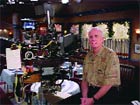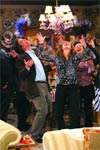BURBANK - The challenge for the producers of CBS's My Big Fat Greek Life is to catch lightning in a bottle a second time. The original product, My Big Fat Greek Wedding, was a mega-hit, the largest grossing independent film ever, and was produced on a low, low budget by Hollywood standards. Now, the simple plan is to tap into that same audience and more - those viewers hungry for tales of wedded bliss within a strictly ethnic family, and to do so on an appropriately low budget.
Jeff Goldstein is an associate producer on the new series and a veteran of network sitcoms and pilots. His role is to turn out the best looking product for Queens Productions at the best price, and in My Big Fat Greek Life he's got potential for a big hit as long as he can trim the fat off the production budget. Shooting in HD rather than film was one cost saver, and choosing the tape stock was another. For this show, shooting a mini-season of seven episodes on Maxell's HDCAM high definition tape was the answer.

DP Gil Hubbs (above) shoots My Big Fat Greek Family on a Sony/Panavision 24p camera using Maxell HDCAM tape, which is made with Ceramic Armor metal particles.
|
SHOOTING 24P
Greek Life is a four-camera shoot before a live audience with two Sony/Panavision 24p cameras on dollies and two on pedestals. But with costs always a concern, Goldstein suggests that use of dollies, with their requisite three-man crew compared to the one-man pedestal, is another tradition that may face the cost-accountant's scrutiny. "A lot of sitcoms are all peds now," he says, "but we were able to get at least two dollies in."
Goldstein has done one sitcom, The O'Keefes, and some pilots, including AUSA, in 24p and his one criticism is shooting speed-ups. "With a speed-up, I'd have to take that shot and lay it off to tape and bring it into an Inferno - but I'm still learning, because it's so new. In the beginning with HD the problem was syncing," Goldstein says. "Now that everybody's got the audio syncing down, they want to do all the things they could do with film."
But, Goldstein is generally happy with life as a 24p producer. "Film is just a lot more work. You go into a telecine bay, you have to transfer all your film to tape, you have to sync all your audio, if you want to do a blow up you have to go back to the negative. It's a much longer process. Whereas with HD, I shoot this show tonight, I'm turning my dailies around the next morning - I'm just making dubs - the audio's already married to those tapes.
"The thing that I like about film is the look. But it adds days to your post schedule. I think the largest benefit with HDCAM is cost. It saves the show an enormous amount of money, and the networks are starting to air in high def." Goldstein points out that, if you shoot on film and need to transfer to HD for network broadcast, you again face high costs. "We broadcast in high def and you don't lose any quality; what you shoot is what you see. I think for sitcoms high def is the best thing that's ever come along."

My Big Fat Greek Life stays away from effects shots, focusing more on laughs.
|
THE TAPE
 |
Another benefit Goldstein has seen is the longer length high def video affords compared to traditional film loads. The 1/2-inch HDCAM tape is made with Maxell's Ceramic Armor metal particles and it uses the HDCAM seven-to-one compression algorithm. The Greek Life shoot uses 40-minute cassettes. "What happens now is the director just keeps rolling," Goldstein says. "With film, generally you do a take, you cut. With HD it's just tape and it's so cheap, the director doesn't see any need to cut. It saves us time on the set, but it gives us an enormous amount of dailies to do." Goldstein estimates that Greek Life shoots two times more HD footage than it would were it a film shoot. "It definitely adds more to the assistant editor's job," he says. "Now he's got to sit there and type in and out numbers for each take, digitize them in and watch it, etc. And then the editor just has a lot more material to cut. It's going to take him two days to get through a show." But HD still saves time versus transferring film, and the production saves a day for each episode shooting this way. "With this show, we're shooting tonight - my assistant editor's rolling tomorrow morning."
HDCAM is 16x9 aspect ratio, but Greek Life still airs in 4x3. "Visual effects become kind of tricky because you're downconverting to 4x3 ratio but have to cover that 16x9 ratio as well. The mindset right now is people aren't so concerned with 16x9, we're still really concentrating on standard TV. But that's going to change - people are going to start buying high def TVs, and it's going to really change the way everybody shoots a sitcom." CBS is simulcasting Greek Life in 16x9 for those viewers equipped to see it.
And DP Gil Hubbs makes sure each shot is protected for 16x9 showing by carefully setting up those left and right flanks outside the 4x3 frame and studying the results on the set's 16x9 monitor.
Moviola provides the production company with the Meridian-equipped Avid system. Editor Barry Gold cuts in 4x3 aspect ratio. "Barry does a great job," Goldstein says, "it's a tough job to do but he's really good."
Goldstein's relationship with Moviola also led to his trying the new Maxell HDCAM tape stock, which was introduced at NAB 2002. Goldstein gets the cassettes at a substantial savings that he feels has a positive impact on his bottom line. The Maxell tape's image quality and color, meanwhile, is beyond reproach. "I think it looks great," he says. "We did a test [with Sony tape] and I couldn't see any difference. In this day and age it's about who's going to give you the quality product for the least amount of money."
Pat Byrne, national marketing manager for Maxell's Professional Media Products Division, agrees: "The visual nuance of My Big Fat Greek Life is the perfect display of the benefits of our HDCAM product," she says. "Our tape was chosen not only for its reliability and cost, but for its high resolution and visual quality that gives the show's creators a wide latitude in creating a beautiful texture. The ability for producers to free themselves from the inherent, cumbersome restraints of film, without sacrificing quality, is causing an industry-wide ripple effect in production technique, where more and more sitcoms are exploring the revolutionary possibilities provided by high definition."
The biggest hurdles in working with high def, Goldstein says, remain doing the "effecty things" like blow-ups, which are not as clean as those done from a film shoot. His production currently stays away from such shots. "The one really great thing I have to say about high def is no dirt," he adds. "There's no film dirt to clean up and that was always an enormous cost. Every week you'd have time set aside to go in and dirt-fix. That's made the job of the associate producer certainly a lot easier." Still, Goldstein allows, "I kind of miss it a little, seeing that dirt pop up. You know, film's got that warmth that HD has not really captured yet. But it will - technology catches up."
As far as imparting the warmth of a world inhabited by a large ethnic Greek family, DP Hubbs goes a long way with lighting the set and actors. "And by the time you downconvert [the HD master] to Digi Beta you're warming it up already," Goldstein notes, "so probably 99 percent of the people watching this at home have no idea we are shooting this on high def. They want to laugh. As long as we're making them laugh, that's all that matters right now. It's exciting; a great show, great writers and you can't ask for anything better than that."
Goldstein firmly believes that HDTV - and HDTV sets - will come to an increasing number of consumers soon. He likens HD's acceptance to that of DVD; now he cannot watch a film on VHS if there's a DVD version available and people will ultimately feel the same about HD.